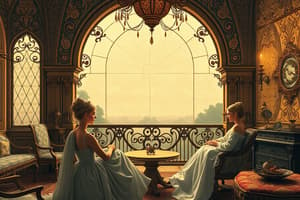Podcast
Questions and Answers
What characterizes Mannerist compositions?
What characterizes Mannerist compositions?
- Strict symmetry and equilibrium
- Clashing colors and elongated limbs (correct)
- Natural shapes and simple architecture
- Balance derived from Palladian elements
Palladianism emphasizes chaos and complexity in architecture.
Palladianism emphasizes chaos and complexity in architecture.
False (B)
Name one characteristic feature of Baroque architecture.
Name one characteristic feature of Baroque architecture.
Dynamic opposition or undulating facades
Trompe l'œil is an art technique that creates the optical illusion that depicted objects exist in __________.
Trompe l'œil is an art technique that creates the optical illusion that depicted objects exist in __________.
Match the architectural term with its description:
Match the architectural term with its description:
Which architectural style is characterized by exaggerated stucco and faux marble?
Which architectural style is characterized by exaggerated stucco and faux marble?
Classicism is not a theme seen in Mannerist works.
Classicism is not a theme seen in Mannerist works.
Who designed the Ospedale degli Innocenti?
Who designed the Ospedale degli Innocenti?
What architectural characteristic is most associated with a palazzo?
What architectural characteristic is most associated with a palazzo?
Mannerism is characterized by natural and graceful forms.
Mannerism is characterized by natural and graceful forms.
Who wrote the first theoretical book on architecture in the Italian Renaissance?
Who wrote the first theoretical book on architecture in the Italian Renaissance?
The ______ is characterized by triangular or semi-circular shapes and is often found atop classical buildings.
The ______ is characterized by triangular or semi-circular shapes and is often found atop classical buildings.
Match the following terms with their descriptions:
Match the following terms with their descriptions:
Which of the following correctly describes the approach to urban planning during the Renaissance?
Which of the following correctly describes the approach to urban planning during the Renaissance?
The High Renaissance focused on exaggerated proportions and complex compositions.
The High Renaissance focused on exaggerated proportions and complex compositions.
What was the significance of Florence Cathedral in early Renaissance architecture?
What was the significance of Florence Cathedral in early Renaissance architecture?
What was a key focus of the Age of Humanism in architecture?
What was a key focus of the Age of Humanism in architecture?
Brunelleschi's work on the dome of Florence Cathedral is considered a hallmark of Renaissance architecture.
Brunelleschi's work on the dome of Florence Cathedral is considered a hallmark of Renaissance architecture.
What principle did Brunelleschi codify that enabled the accurate representation of three-dimensional objects?
What principle did Brunelleschi codify that enabled the accurate representation of three-dimensional objects?
The overall style of Renaissance architecture includes embellishments with classical motifs, emphasizing __________ appearance.
The overall style of Renaissance architecture includes embellishments with classical motifs, emphasizing __________ appearance.
Match the following characteristics with their relevant architectural style:
Match the following characteristics with their relevant architectural style:
Study Notes
Mannerism
- Characterized by masterful compositions with clashing colors and elongated figures.
- Themes often merge Classicism, Christianity, and mythology, resulting in disquieting imagery.
Palladianism
- Emphasizes balance and proportion based on Palladian elements.
- Focus on harmony achieved through symmetrical designs.
Baroque Architecture
- Rejection of strict symmetry in favor of dynamic forms and experimentation with mass.
- Features include S-curves, undulating facades, and oval-based plans, promoting theatricality.
- Use of materials created illusionist effects, enhancing visual drama.
Faux Marble and Trompe L’oeil
- Faux marble consists of exaggerated stucco mimicking real marble.
- Trompe l’oeil creates optical illusions of three-dimensionality using realistic imagery.
Rococo Architecture
- Characterized by natural decorative elements such as leaf shapes and seashell motifs.
- Simpler architectural forms; rectangular rooms with rounded corners to highlight gold arabesque decorations.
Arabesque
- Ornamental motifs comprising garlands of foliage, interlaced in graceful curves, often being inlaid, carved or painted.
Notable Architectural Works
- Ospedale degli Innocenti, designed by Filippo Brunelleschi; a pioneering foundling hospital.
- Palazzo Medici Ricardi, a town house notable for rusticated walls and classical ornamentation.
- Palazzo Rucellai, designed by Leon Battista Alberti, showcasing harmonious proportions.
- Laurentian Library designed by Michelangelo; an example of High Renaissance architecture.
- Il Redentore by Andrea Palladio, embodying Palladian principles.
- Il Gesù by Giacomo da Vignola and Giacomo della Porta, early Baroque church designs.
- The Capitol Hill, a significant architectural project by Michelangelo.
City Planning
- Based on radial street systems centering around important monuments and focal points.
- Utilization of geometric principles to enhance urban layout.
Architectural Character
- Symmetry and proportion based on square and rectangular modules in planning.
- Facades typically symmetrical around a vertical axis with decorative cornices.
Vaulting and Domes
- Domes characterized by circular Roman arches instead of pointed Gothic styles.
- Vaults utilize semi-circular designs without ribs, relying on colored frescoes for effect.
Renaissance Architecture
- Features palazzi that combine rectangular plans, interior courtyards, and classical ornamentation.
- Palazzi serve as urban residences with commercial spaces on the ground floor.
Church Design
- Churches typically compact and centralized, topped with domes.
- Ornate facades decorated with clustered columns and life-sized statues.
Early Renaissance Architecture
- Architectural order principles systematically explored, drawing from classical antiquity.
- Concepts of space organized by proportional logic with a geometric focus.
Printing Press and Humanism
- The invention of the printing press in 1450 democratized architectural knowledge across Europe.
- Age of Humanism shifted focus towards earthly fulfillment and the importance of the individual.
Linear Perspective
- Codified by Brunelleschi, enabling accurate representation of three-dimensional objects on two-dimensional surfaces.
- Planar Classicism features embellishments of classical motifs on walls, preserving a minimalist two-dimensional appearance.
Studying That Suits You
Use AI to generate personalized quizzes and flashcards to suit your learning preferences.
Description
Explore the complexities of Mannerist compositions alongside the balanced aesthetics of Palladianism. This quiz delves into the unique characteristics of Baroque architecture and the profound themes found in Villa Rotonda. Test your understanding of these significant art movements and their attributes.




